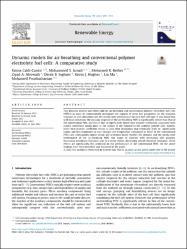Dynamic models for air-breathing and conventional polymer electrolyte fuel cells: A comparative study

View/
Date
2022Author
Calili-Cankir, FatmaIsmail, Mohammed S.
Berber, Mohamed R.
Alrowaili, Ziyad A.
Ingham, Derek B.
Hughes, Kevin J.
Ma, Lin
Pourkashanian, Mohamed
Metadata
Show full item recordCitation
Calili-Cankir, F., Ismail, M.S., Berber, M.R., Alrowaili, Z.A., Ingham, D.B., Hughes, K.J., Ma, L., Pourkashanian, M. (2022). Dynamic models for air-breathing and conventional polymer electrolyte fuel cells: A comparative study. Renewable Energy, 195, pp. 1001-1014. https://doi.org/10.1016/j.renene.2022.06.092Abstract
Two dynamic models have been built for air-breathing and conventional polymer electrolyte fuel cells (PEFCs) in order to comparatively investigate the impacts of some key parameters on the transient response to load alterations and the steady-state performance for each fuel cell type. It was found that with load alterations, the dynamic response of the air-breathing PEFC is significantly slower than that of the conventional PEFC and this is due to significantly slower heat transfer coefficients associated with natural convection taking place at the surface of the exposed-to-the ambient cathode GDL. Namely, lower heat transfer coefficient results in poor heat dissipation that eventually leads to: significantly higher and less-responsive-to-load changes cell temperature (compared to those of the conventional PEFC) and subsequently higher ohmic and activation losses. Further, the dynamic and the steady-state performance of the air-breathing PEFC was found to increase with decreasing GDL porosity, decreasing membrane thickness and, to a lesser extent, decreasing overall electrical resistance. These effects are significantly less profound on the performance of the conventional PEFC. All the above findings have been described and discussed in the paper.















